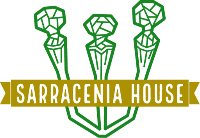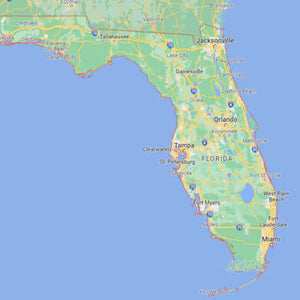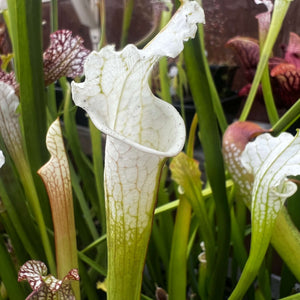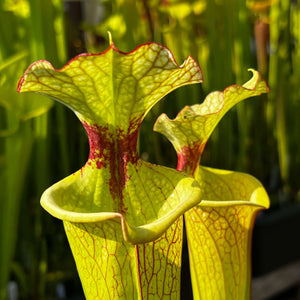Sarracenia
Are pitcher plants hard to keep alive?
Pitcher plants can be somewhat challenging to keep alive, as they have specific requirements for their environment and care. However, with proper attention, they can make interesting and unique additions to a plant collection. Pitcher plants require a moist, acidic growing medium that mimics their natural bog habitat. They also require plenty of bright sunlight. Additionally, they must be watered with distilled or rainwater, as tap water contains minerals that can harm the plants.
Click here for a full Sarracenia care guide.
Are Sarracenia frost hardy?
Most Sarracenia, commonly known as pitcher plants, are frost hardy and can survive temperatures as low as -10°C (14°F) in their native habitats. However, some cultivars may not be as hardy and may require protection from severe winter conditions.
Can I feed my Sarracenia dead flies?
Yes, you can feed your Sarracenia dead flies, as long as the flies have not been treated with any pesticides or chemicals. Sarracenia, also known as pitcher plants, are carnivorous plants that derive some of their nutrients from insects and other small prey that fall into their pitchers. Dead flies can provide a source of nutrients for the plant, but live prey is generally preferred as it contains more nutrients and can stimulate the pitcher to produce digestive enzymes.
Can I use tap water for Sarracenia?
Tap water is generally not recommended for watering these plants. This is because tap water typically contains minerals and other compounds that can harm Sarracenia plants. Over time, these substances can build up in the soil and cause the plant to suffer. To provide the best growing environment for your Sarracenia plant, it is recommended to use rainwater or distilled water to water them. If rainwater is not readily available, you can also use reverse osmosis water that has been treated to remove harmful minerals. In summary, while tap water can be used in a pinch, it is best to avoid it when possible and use rainwater or distilled water for your Sarracenia plants.
Can pitcher plants be overwatered?
Yes, Sarracenia plants can be overwatered. While they require consistently moist soil, they can succumb to root/ rhizome rot if they are left in standing water that's too deep for too long. More so during winter dormancy.
Can Sarracenia be kept indoors?
Yes! Sarracenia can be kept indoors on a sunny south-facing window sill. But they do need a period of dormancy each year so are best moved to an unheated greenhouse for the Winter.
Can Sarracenia be kept outdoors in the UK?
Yes, you can keep Sarracenia outdoors in pots or in bog gardens. S. flava and S. purpurea purpurea do particularly well in UK gardens. Other species, notably S. minor and S. leucophylla do not do so well. Do your research on particular species and hybrid suitability to make impressive outdoor displays.
Can Sarracenia survive winter?
Sarracenia are perennial plants and so are adapted to survive winter in their native habitats. Not all natural habitats are akin to the UK climate though. Some Sarracenia species, such as Sarracenia purpurea and Sarracenia flava, are cold-hardy and can survive freezing temperatures during winter. However, other Sarracenia species, such as Sarracenia leucophylla and Sarracenia psittacina, are less cold-tolerant and may require protection from freezing temperatures or brought into an unheated greenhouse during the winter months.
Can you use Brita water for carnivorous plants?
Carnivorous plants typically require water that is low in minerals, such as distilled or reverse osmosis water, as they have adapted to grow in nutrient-poor environments. Brita water is filtered tap water, which may still contain some minerals and other dissolved substances. While Brita water may be better than regular tap water for carnivorous plants, it may still contain too many minerals and could potentially harm the plants in the long term. Therefore, it is recommended to use rainwater, distilled or reverse osmosis water instead to ensure the best health and longevity for your carnivorous plants."
Do Sarracenia eat spiders?
While spiders may occasionally fall into the pitcher of a Sarracenia and become trapped, they are not a significant part of the plant's diet. The primary prey of Sarracenia are insects, including flies, ants, and beetles.
How do you take care of a Sarracenia?
Sarraceniarequire a bright location with acidic soil for optimal growth. Watering with distilled or rainwater is necessary to avoid mineral build-up that can harm the plant. Fertilization is not recommended, as it can damage the sensitive roots. Regular pruning of dead leaves and pitchers is necessary to maintain plant health. During the winter months,Sarraceniashould experience a dormancy period with cooler temperatures and reduced watering.
Click here for a full Sarracenia care guide.
How long do pitcher plants live?
Sarracenia plants can live for many years, with some species living 20 years or more. However, their lifespan may be shorter in less optimal growing conditions or if they are not properly cared for. It's worth noting that Sarracenia plants go through a period of dormancy in the winter, during which they may appear to die back or go dormant. But with proper care, they will typically emerge again in the spring and continue to grow for many years.
How much water do Sarracenia need?
Keep Sarracenia pots sat in 1-2cm of water at all times. Never allow the soil to completely dry-out. During the winter the water can be reduced to a level that just keeps the soil damp.
Are Sarracenia a perennial plant?
Yes, Sarracenia is a perennial plant. They have a lifespan of several years and are known for their striking and colourful pitcher-shaped leaves that trap and digest insects. Some species of Sarracenia can grow up to 3 feet in height and produce new pitchers each year. With proper care and growing conditions, Sarracenia plants can thrive for many years.
Should I mist a Sarracenia?
Sarracenia is well-suited to high-humidity environments. Although misting can provide some additional moisture to the plant, it is generally not necessary and can actually be harmful if done too frequently or if the plant is allowed to stay wet for too long.
Should I put water in my Sarracenia pitchers?
It is usually not necessary to manually add water to your Sarracenia pitchers. In fact, most Sarracenia species have hoods over their pitchers to prevent them from being flooded with water. An exception to this is Sarracenia purpurea which will collect pools of rainwater.
Should I water my pitcher plant everyday?
During the summer keep your Sarracenia pots permanently sat in a tray of water 1-2cm deep.
What does a Sarracenia plant eat?
Sarracenia, also known as the pitcher plant, is a carnivorous plant that primarily feeds on insects. It uses its modified leaves, which are shaped like a funnel or pitcher, to trap insects. The inside of the pitcher is lined with a waxy surface that makes it difficult for insects to climb out. The rim of the pitcher is also slippery, which makes it hard for the insects to hold onto it. Once an insect falls into the pitcher, it is digested by enzymes secreted by the plant. Some species of Sarracenia have been known to capture larger prey, such as small frogs, snails, and even rodents, but this is rare.
What pots are best for Sarracenia?
In terms of pots, Sarracenia are best grown in plastic pots that are durable and provide good drainage holes. The plastic pots should be made of a material that is UV-stabilized to prevent damage from sunlight. Additionally, the pots should be at least 6 inches deep for large Sarracenia to provide ample room for the roots to grow and to prevent the plant from toppling over.
What to do with Sarracenia in winter?
Reduce watering during the winter months for Sarracenia. Do not let the soil dry out completely but avoid keeping it too wet. Overwatering can cause rot. Sarracenia can tolerate frost but prolonged exposure can increase the risk of damage. To prevent this, you can protect your plants with fleece or move them to a sheltered location like a greenhouse. As the plant enters dormancy, the leaves will begin to die off. Remove any dead material as it appears to keep the plant tidy and prevent fungal diseases.
What's the best soil for Sarracenia?
Sarracenia need an acidic, nutrient-poor soil. The most commonly used soil for Sarracenia is peat moss. This is usually mixed with a substrate such as perlite, vermiculite or sand to help keep the soil aerated. The most popular mix is peat and perlite at 1:1 ratio. There are hobbyists experimented with peat-free alternatives with mixed results, the Peat Free Carnivorous Plants UK group on Facebook is a good place to start your research if that interests you.
Where's the best place to grow Sarracenia?
In the UK, Sarracenia do best in an unheated greenhouse. A greenhouse gives a longer, warmer growing season compared to a garden environment. It also gets cold enough to provide Sarracenia with an essential Winter dormancy.
Why is my Sarracenia dying?
Here are some common reasons why your Sarracenia might be dying. Your Sarracenia soil is too dry. Sarracenia plants require full sun to grow properly. Sarracenia plants need acidic, nutrient-poor soil. Sarracenia plants are vulnerable to insect infestations, such as spider mites or aphids. Sarracenia plants can be susceptible to fungal diseases, such as root rot or botrytis, usually when not given adequate ventilation.
Should You Cut Off Sarracenia Flowers?
The answer varies depending on your circumstances, get more information here from our blog post...
https://sarracenia.house/blogs/articles/should-you-cut-off-sarracenia-flowers
 UK-grown carnivorous plants
UK-grown carnivorous plants



